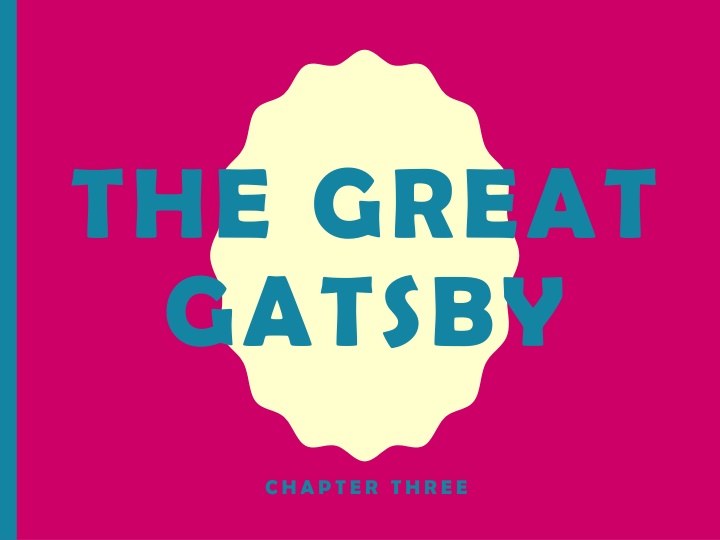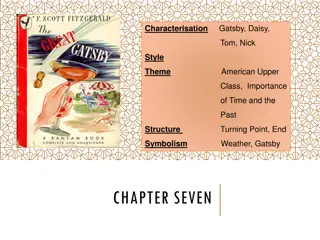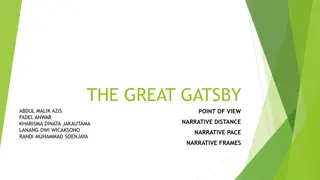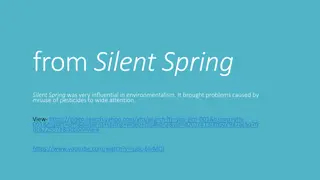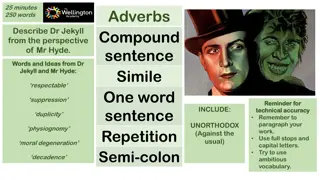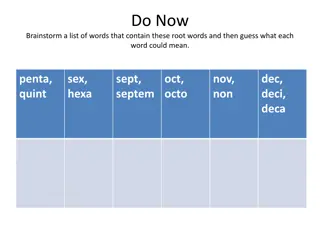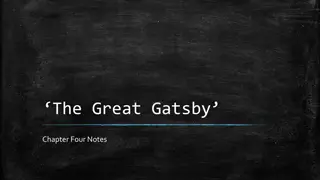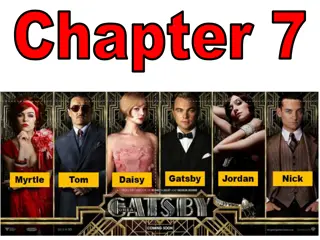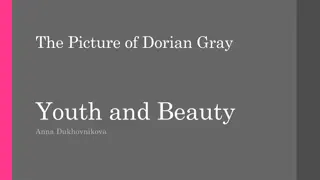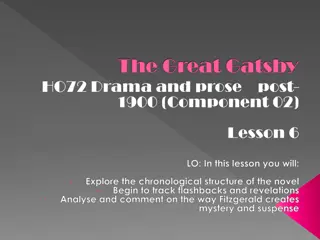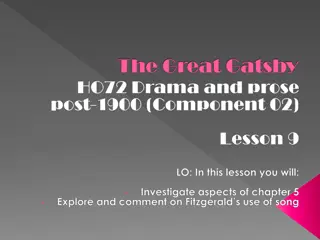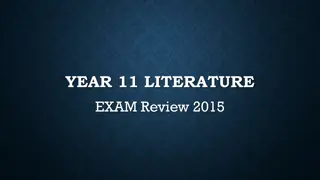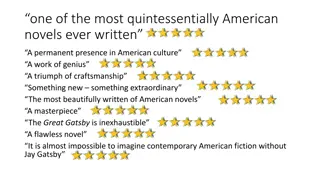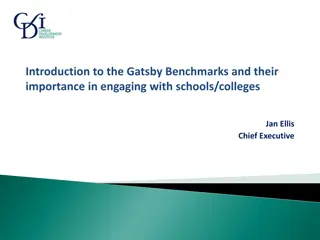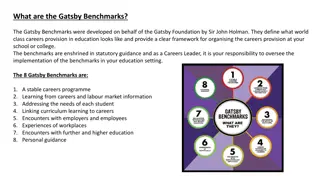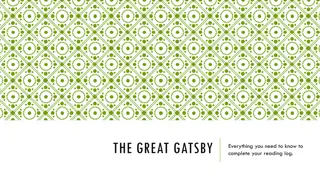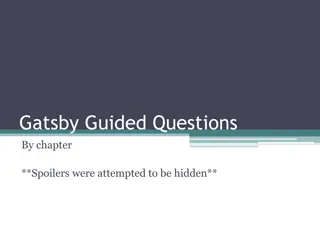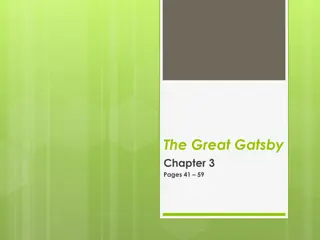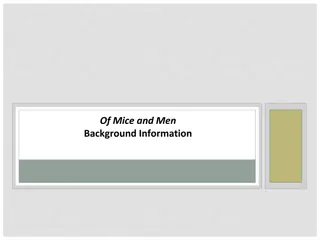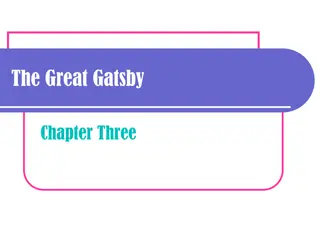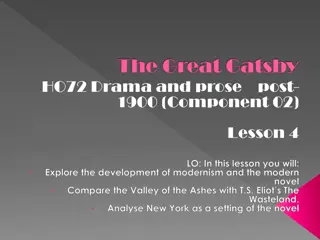Decadence and Wastefulness in The Great Gatsby - Chapter Three
Chapter Three of The Great Gatsby delves into the decadent and wasteful hedonism of the Jazz Age, epitomized by Gatsby's extravagant parties filled with rowdy parasites. Through vivid imagery and symbolism like moths and excessive consumption, Fitzgerald critiques the artificial rush and emptiness of social interactions in this era.
Download Presentation

Please find below an Image/Link to download the presentation.
The content on the website is provided AS IS for your information and personal use only. It may not be sold, licensed, or shared on other websites without obtaining consent from the author.If you encounter any issues during the download, it is possible that the publisher has removed the file from their server.
You are allowed to download the files provided on this website for personal or commercial use, subject to the condition that they are used lawfully. All files are the property of their respective owners.
The content on the website is provided AS IS for your information and personal use only. It may not be sold, licensed, or shared on other websites without obtaining consent from the author.
E N D
Presentation Transcript
THE GREAT GATSBY CHAPTER THREE
LEARNING INTENTIONS Understand how this chapter portrays the decadent, wasteful hedonism of the Jazz Age Identify the main symbols used in the chapter and how they increase your understanding of the main themes Meet Gatsby and begin to think about how he is represented
GATSBYS PARTIES This chapter accurately summarises the decadent, wasteful hedonism of the Jazz Age. Gatsby s parties are shown to the theatrical ; affairs, attended by uninvited and rowdy parasites. The host himself is aloof, even separate, from his guest.
THE PARASITIC QUALITY OF THE PARTYGOERS men and girls came and went like moths among the whisperings and the champagne and the stars The moth image symbolises the guests moving towards Gatsby s light . Although the imagery here seems delicately positive (whisperings, champagne and stars), Fitzgerald urges us in this chapter to peer beneath the false veneer, the guest are ultimately shown to be buzzing flies drawn to the detritus of Gatsby s backyard: People were not invited they went there and after that they conducted themselves according to the rules of behaviour associated with an amusement park.
PARTYGOERS This is symptomatic of the artificial rush required by these people in order for them to enjoy life: like those waiting in line at a roller coaster, they breathlessly anticipate the game of social interaction and its attendant levels of hilarity and hysteria. They trash Gatsby s backyard, endlessly consuming and regurgitating food, drink and opportunities for mindless and empty conversation.
PARTYGOERS- EXCESS Five crates of oranges and lemons a corps of caterers several hundred feet of canvass garnished with glistening hors-d oeuvre, spiced baked hams croded against salads of harlequin designs and pastry pigs and turkeys bewitched to a dark gold The first supper there would be another one after midnight
WASTE The transitory nature of possession is highlighted in the waste produced by the partygoers. FIND A QUOTE WHICH DEMONSTRATES THIS
WASTE The transitory nature of possession is highlighted in the waste produced by the partygoers. Every Friday five crates of orange and lemons arrived from a fruiterer every Monday these same oranges and lemons left in a pyramid of pulpless halves.
THE COLOUR YELLOW We have already seen a connection between yellow and false hope (the Wilsons yellow brick house) and decay (the faded yellow of Dr. TJ Eckleberg s gigantic eyes).
THE COLOUR YELLOW The symbolism extends to Gatsby s station wagon scampering like a brisk yellow music to meet his various guests from their trains; to the yellow cocktail music which plays as the earth, significantly, lurches away from the sun ; to Jordan Baker s golden arm and to the twins in yellow dresses who indulge in drunken behaviour and gossip fiercely about their host.
THE COLOUR YELLOW Each of these props in the scene, on some level, are false: Gatsby s car fetches guests who don t care for him; the yellow music is brassy, and eventually reaches a hysterical pitch; Jordan s arm is symbolic of her golden allure, which hides her deceit and spiritual vacuity; the twins are the visual epitome of the careless excess displayed by the partygoers at large.
WASTE Since Gatsby is interested in presenting pure theatre for his guest, no expense is spared. Nick details the trails of food, drink and d cor processed on the weekends of these parties, subtly documenting the wastefulness on show: Every Friday five crates of oranges and lemons arrived from a fruitier in New York every Monday these same oranges and lemons left his back door in a pyramid of pulpless halves. The process of consumerism and its corrupting effect - is clearly shown here. The crowd at the party is again portrayed as a relentless machine which devour everything. The piles of fruit peel therefore come to represent more than mere rubbish heaps they stand for waste and greed.
GATSBY The reader is finally introduced to Gatsby in this chapter and this delay reinforces his mysterious and enigmatic qualities. Even when he first appears, Gatsby is unassuming and detached from the party which is in stark contrast to the behaviour of his partygoers.
GATSBYS ENTRANCE An important authorial technique in heightening climax is delay. Fitzgerald delays Nick s meeting with Gatsby until this chapter, although our interest is aroused when Nick first sees him, especially when his behaviour is so odd. These points all contribute to the climax of the eventual meeting. Instead of making some ceremonial entrance, Gatsby stumbles to Nick s attention almost by accident. This is key to understanding Gatsby s relationship with his guests they do not now what he looks like, and he is easily overlooked. The language used by Nick are very complimentary and warm which is bound to have an effect on us, the reader, so we begin to like him just as Nick does.
GATSBYS SMILE His smile proves immediately enigmatic, and seems to symbolise the man himself: It was one of those rare smiles with a quality of eternal reassurance in it it faced - or seemed to face the whole eternal world for an instant it understood you just as far as you wanted to be understood, believed in you as you would to believe in yourself and reassured you that it had precisely the impression of you that, at your best, you hoped to convey. Precisely at that point it vanished.
GATSBYS SMILE This smile reflects Gatsby s passion for hope. It follows a path toward something full of promise, then it just stops We are therefore given some very early clues about Gatsby's association with the conflict between fantasy and reality. We don t know yet how much of him is real. He certainly keeps apart from the other guests and this proves to be a point in his favour, from what we have learned in the first 3 chapters he doesn't drink, he is excessively kind and makes a clear attempt to befriend Nick, who we can clearly establish as being a reliable and solid character. But something just doesn t ring true. Why is he doing this for the parasitic guests? Why does he waste money on these orgies of self indulgence? Why does he use affections such as old sport in his speech? Why does his smile promise so much yet deliver so little?
GATSBY RUMOURS The mysterious and elusiveness of Gatsby is heightened by the ridiculous rumour mill surrounding him. I don t think it s so much of that, argued Lucille sceptically; it s more that he was a German spy during the war. You look at him sometimes when he thinks nobody s looking at him. I ll bet he killed a man.
GATSBYS PARTIES During the parties, Gatsby removes himself from the action. His sobriety and detachment is in stark contrast to his guests. This party introduces him as the showman with the Vaudeville moniker The Great Gatsby which alludes to the tremendous attention to detail he has. The sole purpose of these parties are to attract Daisy which emphasises his strength of desire for her. They are overtly lavish and ostentatious which symbolises the materialism and conspicuous consumption prevalent at this time.
GATSBY AND THE MAJOR THEMES Illusion vs. Reality Gatsby looks like he belongs to the elite but in reality his attempts are gauche and unconvincing to anyone but him. This social naivety is emphasised throughout the novel. Old World vs. new World While Gatsby belongs to West Egg he goes to enormous lengths to show his alliance with the old world: house modelled on French Hotel de Ville; car is a Rolls Royce which is typically old world; library is old world/European Gothic style and Old Sport which is a typical anglophile phrase.
GATSBY AND THE OWL EYED MAN The Owl Eyed man represents the inherent blindness and lack of vision prevalent in society at that time. Ironically he is one of the few who attend Gatsby's funeral. He is not impressed by the library per se but rather Gatsby s attention to detail.
THE SYMBOL OF THE CAR The automobile was a fairy recent invention and therefore a rare commodity in 1922, but it features very strongly both as an aspect of the narrative and as a symbol throughout the novel. The car that is crashed by a drunk driver at the end of the chapter symbolises the potentially destructive effects of industrialisation and mass consumerism. The invention of the car has progressively caused a road safety hazard in the twentieth century that was effectively non-existent in previous time. Fitzgerald is asking whether the price we pay for these dangerous commodities of convenience is too high.
THE SYMBOL OF THE CAR Foreshadows the accident at the end The care is again shown as a metaphor for the carelessness and selfishness of the Egg set at the end of the chapter during a conversation between Nick and Jordan. It reveals the selfishness of the upper classes who don't feel the normal codes of conduct apply to them.
Gatsby reveals the most amazing thing to her again reinforces his mystery. I hate careless people That s why I like you an admission that she is one of those careless people . Jordan Baker for a moment I thought I loved her emphasises the fleeting and insubstantial nature of love. These feelings cannot always be relied upon. She was incurably dishonest also linked to the theme of illusion vs. reality as we expect sportspeople to behave with integrity and honesty.
JORDAN Jordan asserts that she does not need to take care when driving because other people will take care on her behalf. When asked by Nick what she will do if another bad driver were to encounter her on the road, she says: I hope I never will. I hate careless people. That s why I like you . The irony of this is not lost on the reader or Nick, who reflects at the the end of the chapter that she is one of the few honest people I have ever known .
